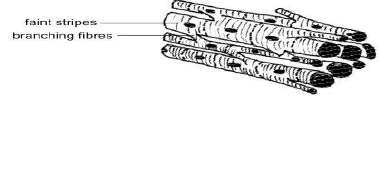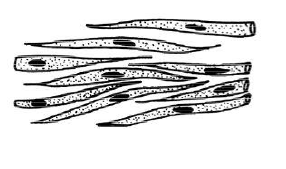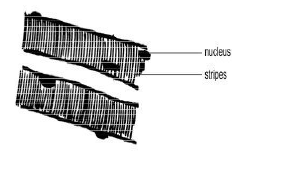i)Cardiac muscle:
Cardiac muscle is found only in the walls of the heart where it produces the ‘heart beat’. Cardiac muscle cells are branched cylinders with central nuclei and faint stripes (i.e. they appear cross striated when viewed under a light microscope, the cross striations being due to alternating light and dark bands). Each fiber contracts automatically but the heart beat as a whole is controlled by the involuntary autonomic nervous system. Cardiac muscle forms the heart- used to pump blood through circulatory system, work involuntary

Cardiac muscle fibers are shorter than those of skeletal muscles and they are connected to each other, end to end, by specialized surface specializations called intercalated discs.
Action potential can spread from one cardiac muscle cell to another across these discs.
In this process the action potential spreads through a large population of cardiac muscle cells as if they were a functional syncytium. Thus the heart will be seen to contract as a unit.
The principal physiological difference between heart and skeletal muscle is the spontaneous nature of the cardiac beat and its rhythmic contraction, which is not subject to voluntary control
ii) Smooth muscle: (muscle of muscle of the viscera) lines gut and blood vessels- controls diameter of these tubes and in gut helps to propel the digested food. Work involuntary and is found within the walls of organs and structures such as the esophagus, stomach, intestines, bronchi, uterus, urethra, bladder, blood vessels, and the erector pili in the skin (in which it controls erection of body hair).
Unlike skeletal muscle, smooth muscle is not under conscious control. They also lack cross striations. Smooth muscle consists of long and slender cells with a central nucleus (see diagram 4.9). It is found in the walls of blood vessels, airways to the lungs and the gut. It changes the size of the blood vessels and helps move food and fluid along. Contraction of smooth muscle fibers occurs without the conscious control of the animal.
The cells of smooth muscles are closely associated/arranged in bundles or sheets such that the thick middle portion of one is juxtaposed to the thin ends of adjacent cells. The cytoplasm of muscle cells is called sarcoplasm.
In smooth muscle the cytoplasm is homogeneous after routine fixation and staining. However, after the use of special stains, the longitudinal striations that run the full length of the cell can be demonstrated. These are the myofibrils which are also the contractile units of the muscles Smooth muscle contractions are slower than other types of muscles, and they are also able to sustain forceful contractions for long periods of time with relatively little expenditure of energy. Contraction may be initiated by nerve impulses, hormonal stimulation or local changes arising within the muscle itself e.g. stretching of the muscle fiber

iii)Skeletal Muscle
Skeletal muscle (sometimes called striated, striped or voluntary muscle) has striped fibers with alternating light and dark bands. It is attached to bones (skeleton) and is under the voluntary control of the animal. Skeletal muscle attaches to bones which form levers- used for bodily movement. Voluntary muscle is anchored by tendons (or by aponeuroses at a few places) to bone and is used to effect skeletal movement such as locomotion and in maintaining posture. An average adult male is made up of 42% of skeletal muscle and an average adult female is made up of 36% (as a percentage of body mass)

marto answered the question on
April 16, 2019 at 08:09